Resources
Employee Suggestion Programs
A guide for City and County Governments
If you are looking for information on employee suggestion programs for City and County governments, then you’ve come to the right place. In this guide you’ll find info about:
- What a successful County and City program looks like
- The benefits of a suggestion program – why should you get one going?
- How to implement a suggestion program at your County or City
- Details about your options - online suggestion box, paper, electronic form...
- Developing a policy for your Employee Suggestion Program (ESP)
- Naming your Program
- A comprehensive list of suggestion programs in all 50 States – to help you find advice from someone nearby.
- What a successful County and City program looks like
- The benefits of a suggestion program - why should you get one going?
- Improved operational efficiency (Save time, labor, space, material, supplies or money) – improved efficiency also benefits the public, which leads nicely on to…
- It’s good Public Relations! The media loves reporting on successful schemes: Arizona-Central, Kentucky Examiner and Sun Sentinel
- Improved Employee Morale - by enabling employees to achieve more control over their environment through use of their ideas
- Increased Job Satisfaction
- Increase cooperation between employees and management
- Improve service, or safety conditions
- Eliminate unnecessary procedures, records, and forms
- How to implement a suggestion program in your City or County
- Develop a clear Internal Policy: See Section 5 for more.
- Decide how you are going to collect Ideas: See Section 4 (below) about your various options for collection.
- Launch the scheme, Listen to and act on employees’ ideas: Ask and you shall receive. Some employees are overflowing with suggestions to help the business and are just waiting to be asked. Others can build on their colleague’s ideas and are more likely get behind a project if they are there right at conception.
-
Focus attention – ask for suggestions on specific areas: Focusing employees around a specific area has two main benefits. Firstly, focusing on one area helps people actually think up more ideas. Secondly, if you get some quality ideas around a particular area and can then make changes in that area, you’ll very rapidly have tangible successes to point at to the various stakeholders.
A good example of this is Baltimore’s ‘Baltimore City Innovation Bank’ scheme. Here’s an excerpt from their press release - "To pilot the program, the Innovation Team issued a staff challenge, a two-week competition in which employees were encouraged to submit their innovative ideas to improve policies and procedures, management practices, and daily activities. They were also encouraged to submit ideas that increased productivity, decreased waste, and saved money. The challenge was a huge success, with 64 ideas submitted." -
Keep employees informed on what’s going on with the Idea they submitted: We’ve found that one of the 2 main motivators that motivate an employee to submit an Idea is – seeing their idea being implemented. Employees want to know what’s going on and so your system should have an in-built, reliable feedback mechanism. San Francisco publishes results. Baltimore decides each quarter but we reckon that’s a bit too long of a wait: The Innovation Bank Committee will meet quarterly to make decisions on innovations and prizes. The committee will announce the “Innovation of the Quarter,” and annually the committee will choose the “Innovation of the Year.” The committee is consists of Ed Gallagher, Director of Finance, Gladys Gaskins, the Director of Human Resources, Deputy Mayor Chris Thomaskutty, First Deputy Mayor Andrew Frank and Karen Miller, Deputy Director of Communications. We’ve found that one of the 2 main motivators that motivate an employee to submit an Idea is – seeing their idea being implemented. Employees want to know what’s going on and so your system should have an in-built, reliable feedback mechanism.
San Francisco publishes results. Every quarter, Baltimore’s Innovation Bank Committee meet to make decisions on innovations and prizes. The committee then announces the "Innovation of the Quarter", and each year the committee selects an "Innovation of the Year." These are all admirable initiatives but we reckon just a simple update email will do the job. - Keep employees informed on the bigger picture: When an employee knows how their small piece fits into the bigger strategy, they’ll feel more motivated to succeed. Harvard Business School’s Rosabeth Moss Kanter puts it well "If you want everyone to be on the same page, put the page in front of them conveniently and often.". Wrightsville Beach Town Manager Tim Owen commented "The program can benefit both local government and town employees through improved communication between employees and supervisors which creates a closer working relationship" and "Productivity becomes a team goal rather than a directive from the supervisor or manager."
- Say thanks – recognize their contribution: The simplest way to say thanks is with an email or phone call. A step further would be a mention on a public noticeboard, website or newsletter. Cash rewards are very common (see the Policy section below) too but there are also a variety of creative ways that staff can feel the appreciation, here are some ideas.
- Your options - online and offline
- An online suggestion box
- A simple online suggestion form
- A print-out and email/mail-in suggestion Form
- A wooden/plastic/metal suggestion box
- An online suggestion box
- Mandatory data: Usually employees log in to the online suggestion box and submit their ideas. This means everything is automatically tracked and administrators can follow up with the submitter easily. Mandatory boxes/fields are also built in to an online suggestion box so ‘incomplete information’ is not a problem. Most software has features such as Tagging too, to help you keep everything organized.
- Employee involvement in the process: If the online suggestion box you create has voting and commenting, employees will feel that they have a ‘say’ in the running of their organization. It also helps with the evaluation process if reviewers are aided by a high/low rating. Commenting is also a simple way that ideas can be built upon and improved. We do not recommend anonymous commenting, that’ll only lead to trouble!
- In-built reviewing/follow-up methods: We’ve looked at many different online solutions and all seem to have some way to give feedback to the submitter. This is a major benefit as the system is then self-contained and senior management can easily see a top-down overview.
- sQuick to set up: Usually there’s nothing to install and you can just sign up online. Some providers will force you to do a sales demo (we don’t) and some required you to input a credit card to start a demo. That said, it’s probably still as quick as any of the other 3 options mentioned here.
- Costs (some providers are not expensive): If you want something that efficiently captures ideas from employees and provides simple tools to help you review and organize them – Vetter is one solution that does this. Of course, we’re biased! so just to be fair, here are some other solutions that are cost-effective HunchBuzz and SuggestionOx. Unless you want a fancy-pants custom solution, you don’t need to be paying over $1 per employee per month. $0.50 should be your target and is a very palatable price for your local government’s committee to approve (should that be needed).
- Costs (some providers are expensive): Some software providers I am told, Kindling for example, charge about $8 per user per month. If you’ve got 1000 employees, you’re looking at $80,000+ per year even after heavy discounts. BrightIdea and Spigit and will quote close to and often above the $100,000 mark, our customers have told us. A big pay out!
- Employees need access to a computer/smart-phone: There are ways around this (providing a PC in a semi-public place that employees can use for example), but it is still a disadvantage that warrants mentioning.
- A simple online suggestion form
- Quick to set up: You could set up a form with SurveyMonkey.com in 5 minutes (that’s what the City of Memphis did, check out there form here: link
- Low cost: SurveyMonkey, for this kind of purpose, is free. You may need to get someone from I.T. to spend an hour or two adding a link to your website or even embedding the form itself on your site, but otherwise it’s free!
- Mandatory data: You can specify what exactly you want. If you need to know what department an employee is in, it’s simple to set up a drop down menu. Need to know their email address – then make it a mandatory field (they can’t submit the form without filling it in). We suggest you make it mandatory to fill out the following boxes, at a minimum: 1) Name, 2) Email, 3) Idea Title (this’ll make it easier to identify it and discuss it internally); 4) My suggestion will a) save money, b) increase revenue, 3) improve safety, 4) Make operations more efficient/effective.
- Lack of inbuilt reviewing/follow-up methods: With this type of solution, there is no way to follow up without drafting a new email or letter or a phone call.
- Spam – spam robots (yes, they exist): Spambots that crawl the internet will find your form and submit gobbledygook, often on a daily basis. I guess it’s the internet equivalent of junk mail and we’ve just got to tolerate it!
- Memphis suggestion program
- Mecklenburg County Suggestion Box
- Portland City, Oregon
- A print-out and email/mail-in suggestion Form
- Low cost: The major investment is time. The creator of the form needs to figure out what’s needed and create a template. We have a free template, which you can find here, in case you need one. After that, somebody from I.T. will need to help host it either on your website or on the employee internal portal.
- Mandatory data: Just like the online form above, you can specify what exactly you want. If you need to know what department an employee is in, it’s simple to set up a drop down menu. Need to know their email address – then make it a mandatory field (they can’t submit the form without filling it in). We suggest you make it mandatory to fill out the following boxes, at a minimum: 1) Name, 2) Email, 3) idea title (this’ll make it easier to identify it and discuss it internally); 4) My suggestion will a) Save Money, b) increase revenue, 3) improve safety, 4) Make operations more efficient/effective.
- Lack of inbuilt reviewing/follow-up methods: Again, with this type of solution, there is no way to follow up without drafting a new email or letter or a phone call. Nothing is any way 'automated'.
- Inefficient and time consuming: Manually sorting through the content is required. This will take time. What's more – if it’s a success, then you’ll probably have to dedicate an employee or several to administrating it. It's a Catch 22.
- City of Sarasota (Fl)
- Knox County Staff Suggestion Scheme(TN)
- Sonoma County
- A wooden/plastic/metal suggestion box
- Visibility: Assuming your organization purchases enough of them, these boxes will be very noticeable and will be seen by employees, management, visiting elected officials, and the public.
- Low cost: Well....sort-of. These Classic acrylic suggestion boxes are cheap. In contrast, you'll pay $154 a piece for a Free Standing Black Acrylic Secure Drop Box, 15"w x 52"h x 14-Inch, Anti-Theft Interior Panel.
- Poor reputation: Suggestion boxes have a bad reputation as being 'black holes’ that things go into and never come out of. You’ll be fighting against this right from the off.
- Lack of inbuilt reviewing/follow-up methods: It’s just pieces of paper in a box. There is no way to follow up without drafting an email or letter or a phone call. Nothing is built-in or automatic.
- sInefficient and time consuming: Same as as No.3 above, manually sorting through the content is required. This will take time. What's more – if it’s a success, then you’ll probably have to dedicate an employee or several to administrating it. It's a Catch 22.
-
Risk of receiving Incomplete information: With an online system, you can have a box for 'name’ 'email’ and 'department’ and if the suggester doesn’t fill those out, then the system can refuse to accept them. It’s not this way with a suggestion box, a box takes all - incomplete suggestions, complete suggestions, old dry cleaning receipts! - Jones County, Georgia
- Denver
- Developing a policy for your Employee Suggestion Program
- Eligibility for Submission of Suggestions: Most programs do not allow all employees to participate. The most common exceptions, which we saw with the cities of Salem an Riverside, were "Every employee is eligible to participate in the Employee Suggestion Scheme with the following exceptions: City Managers, Assistant City Managers, Department Heads, Managers/Supervisors."
-
Eligible and Ineligible Suggestions: Every policy we studied covered this. It’s vital. People need guidance as to what is eligible. Here is a screenshot of this section from the policy of the County of Sonoma (California):
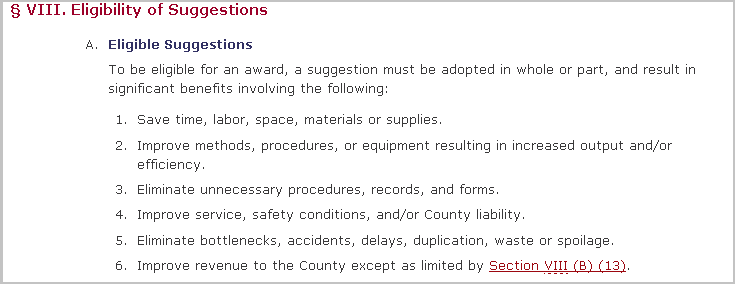
Here are Sonoma's guidelines on what's ineligible as a suggestion:
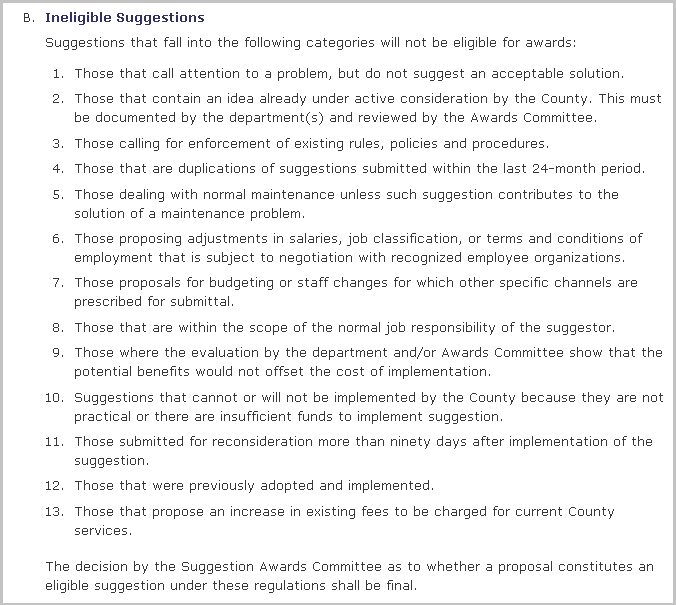
-
Cash awards - what will be paid out? Clearly defined cash awards will prevent a lot of headaches down the road. Every city and county suggestion program we examined paid out cash rewards. On average they paid out 9% of the resulting 1st year of savings, with a limitation of an average of $1414. Of course, it’s pretty straightforward when the savings/gains are easy to calculate. That’s why you need to define the payout if the saving/gain is intangible. The City of Salem has an excellent policy for intangible awards.
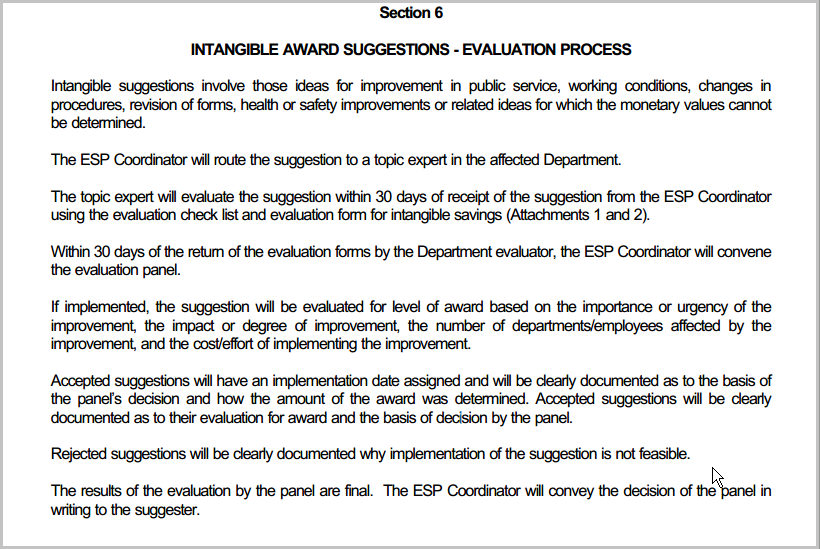
- Ownership of Suggestions: This is an easy one to forget as its usually short and sweet. All you need to do is state: “All suggestions shall become the property of the _insert name of your organization here_ and shall not form the basis of a future claim upon the _insert name of your organization here_ by the suggester/employee, his/her heirs, successors or assigns, including suggestions which are subsequently patented".
- Reviewing suggestions – committee and review time: We reckon the key thing to include in your policy is not the make-up of the committee but the amount of days needed to review suggestions. Employees will get restless if they submit a brainwave and have no idea when it’ll be assessed. You should clearly communicate the review period, ideally in a statement such as “Suggestion will be reviewed within x days, after which the employee who suggested the idea will be notified on the decision”. We recommend a review within 30 days.
- Goals of the program: A nice clear statement of the Goals of the program is a good way to open up your Policy document. The County of Manatee (Florida) has a good one: The Manatee County PRIDE (Proudly Recognizing Innovative Dedicated Employees) Program is designed to encourage and recognize employees who propose procedures or ideas that, if adopted, result in reducing costs, improving working conditions or work performance, and/or providing better services to Manatee County’s clientele. PRIDE is also designed to allow department directors to nominate an employee for outstanding and exemplary performance or achievement.”
- Duplicate suggestions: This may be obvious but you do need to include in your policy a statement that if duplicate suggestions are received, the first one is the one that is accepted and the committee (or Administrator’s) decision on what is a duplicate and what is not, is final. Some governments have a policy of allowing a suggestion that was deemed to be a duplicate, to be submitted again after 2 years (Salem has this policy). I must say – the City of Salem would probably win ‘Policy of the Year’ if there were awards, maybe Vetter should create such an award!
- Definition of Terms: If your policy is a long one, it makes sense to define what are such things as ‘Intangible’, ‘Net savings’ and even ‘Employee’ (as some employees might not count – example the Mayor).
- Anonymity: Some local governments, such as Sonoma County, the City of Riverside and the City of Salem give the option for suggestion's submitter to remain anonymous. We note that they do have to submit their name along with the idea, but their identity can be kept secret if they wish. We like this way of doing it – requiring a name stops negative stuff being submitted, while permitting anonymity will reduce the fears that you are undermining your boss if you submit something that will directly affect your own department.
- Naming your Suggestion Program
- SHINE - Suggestions Help Increase & Nurture Excellence - Polk County, Florida
- STAR - Successful Thoughts are Rewarding - Wisconsin Department of Transportation
- SMART Suggestion - National Weather Service
- Innovation Bank - Baltimore, Maryland
- ImproveSF - San Francisco
- IDEA Program - U.S. Airforce 1
- Every Dollar Counts - U.S. Airforce 2
- A list of suggestion programs in all 50 states – to help you find advice from someone nearby...
- Alabama - State
- Alaska - City of Seward
- Arizona - Maricopa County
- Arkansas - State
- California - Kern County
- California - State
- Colorado - Denver
- Connecticut - State
- Delaware - N.A.
- Florida - Manatee County
- Florida - Polk County
- Florida - Satasota County
- Georgia - State
- Hawaii - Honolulu
- Idaho - N.A.
- Illinois - State
- Indiana - State
- Iowa- N.A.
- Kansas - State
- Kentucky - State
- Louisiana - N.A.
- Maine - State
- Maryland - Baltimore
- Massachusetts - N.A.
- Michigan - Town of Waterford
- Minnesota - N.A.
- Mississippi - N.A.
- Missouri - State
- Montana - N.A.
- Nebraska - State
- Nevada - Washoe County
- New Hampshire - State
- New Jersey - State
- New Mexico - N.A.
- New York - Town of Amherst
- North Carolina - Elizabeth City
- North Dakota - State
- Ohio - Hamilton County
- Oklahoma - State
- Oregon - State
- Pennsylvania - N.A.
- Rhode Island - N.A.
- South Carolina - N.A.
- South Dakota - State
- Tennessee - Knox County
- Tennessee - Memphis
- Tennessee - State
- Texas - Houston
- Utah - N.A.
- Vermont - N.A.
- Virginia - State
- Washington - State
- West Virginia - State
- Wisconsin - State
Success at County Level - Broward County, Florida

Replacing road signs, light poles and traffic control cabinets might not be the most exciting idea to enter a suggestion box, but for the County of Broward, Florida it saved $78,000. The idea was a joint effort from Joseph Crackel, William Gallo and Robert Pagoota, who worked in the County Traffic Engineering Department.
Co-ordinator Susan Dellcioppia said "This program is designed to recognize employee innovation, stimulate morale, and increase productivity by finding ways to save money, perform public work more quickly and cheaply and to respond more effectively to the needs of the public". The program is aided by clear guidelines on what happens to suggestions - To thank employees, Broward County of Florida gives every staff member that submits an eligible suggestion a certificate of recognition. After that, the ideas are evaluated, sorted and classified and reviewed by a committee. Adopted ideas can get a payout of $50-3000. The three men mentioned above each gained $3000 for their suggestions (for more on cash rewards, see the Section 5 - Developing a policy for your Employee Suggestion Program).
Another successful suggestion came from mechanic Orlando Mayers who suggested that the County centralize the fleet services’ tire repair and replacement service at one main depot. The suggestion was implemented and saved the county $13,330. Mayers himself picked up a tasty $1,333.
Management support at all levels was also key to the success of the program, William Gallo (a 20+ year veteran county staff member) said "We just threw a few ideas around until we came up with a more cost-effective plan. Our director, Richard Ronskavitz, supported us 100 percent. He made sure that we had the equipment we needed and gave us the go-ahead."
Source
Success at City Level - Phoenix, Arizona
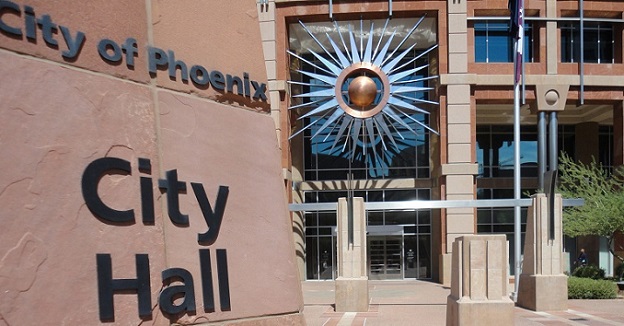
Recessions and funding cuts have boosted the popularity of Phoenix’s employee suggestion scheme, which has been around for over 30 years. The city’s deputy director of human resources (at that time) James May spoke of a 75% increase in suggestions in recent years.
So what kind of suggestions is the scheme, which saw savings of $435,720 from just 20 implemented ideas in 2010, getting from their staff? Examples include changing soap dispensers at the Phoenix Convention Center for more efficient model (savings = $94,000) and reusing/recycling grocery bags to pick up dog poop, instead of buying specialist Mutt Mitt bags (that saved more than $60,000 annually and I doubt if the dogs cared!)
A blockbuster idea and one of those "I could have thought of that" ideas was the recommending to paint all the buses serving the Airport, the same color. That makes switching buses on to different routes easier, requiring fewer buses. It saved an amazing $2.4 mn!
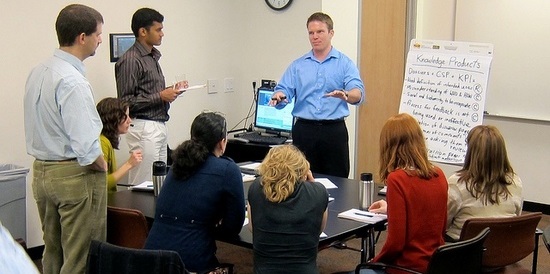
We’ve talked to the administrators of programs and customers of Vetter and come up with 5 main benefits of getting a suggestion program going at your government department. Before we dive into the list, I'd like to first look at cost savings. It warrants a separate discussion.
Cost savings are often both the initial motivator to a county or city official to get a program started and is usually what the success is measured by. Cost savings are usually the benefit that hits the headlines. The benefits listed below are really important too, but if you want to a) please senior management, b) impress the public/voters; and c) measure the impact in hard $$s, then cost savings are key. Every program must therefore deliver some cost savings. An example of this is the city/village of Downers Grove, just outside of Chicago. Examples of the success of this program are two-sided printing on all Village Hall printers (estimated savings of $1,000 per year), and the consolidation of dispatch services between Downers Grove and neigh-boring Westmont (approximately $300,000 in savings per year) (click here for more. Here are some other benefits so launching a suggestion program in your city or county:
We've identified 7 key steps to implementation:
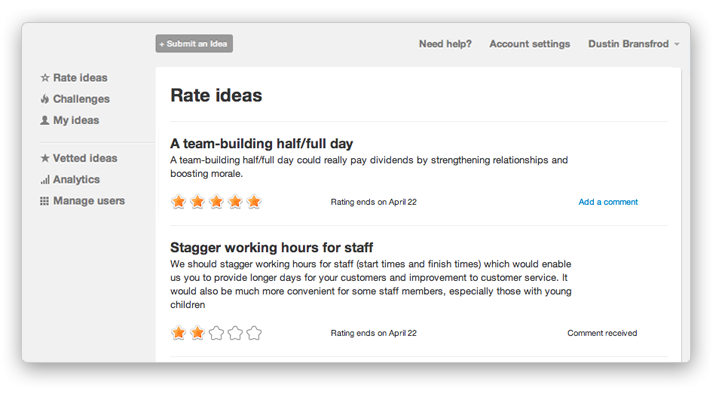
Advantages
Disadvantages
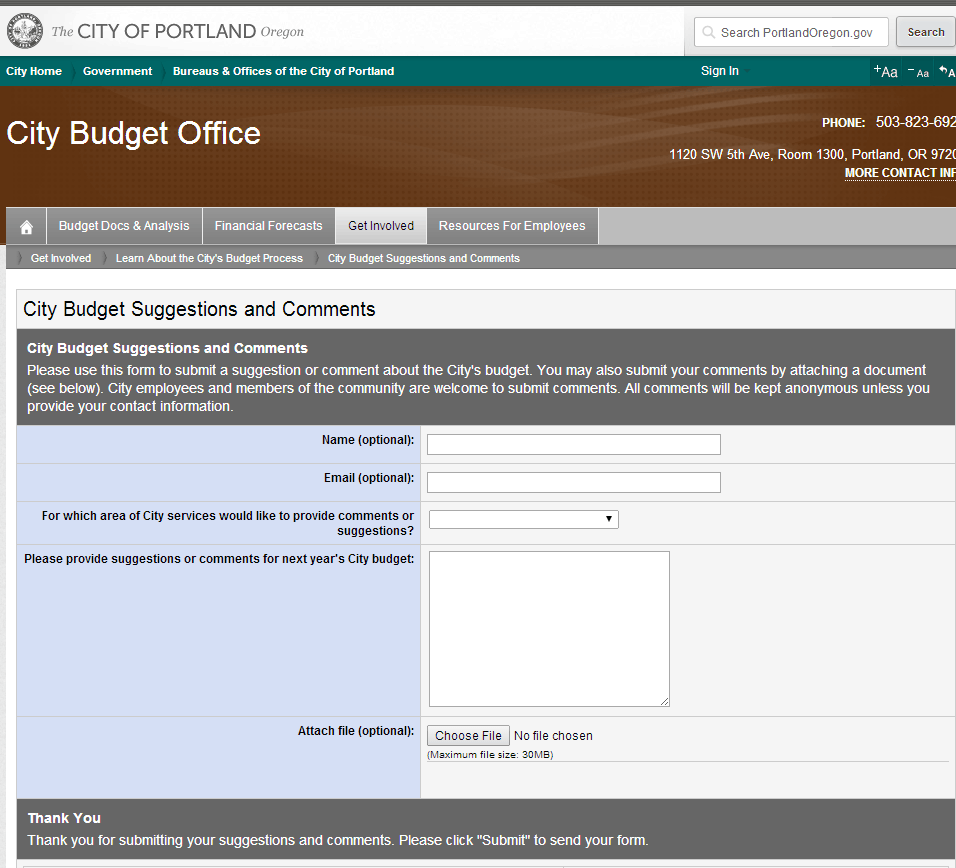
Advantages
Disadvantages
Used by (amongst others):
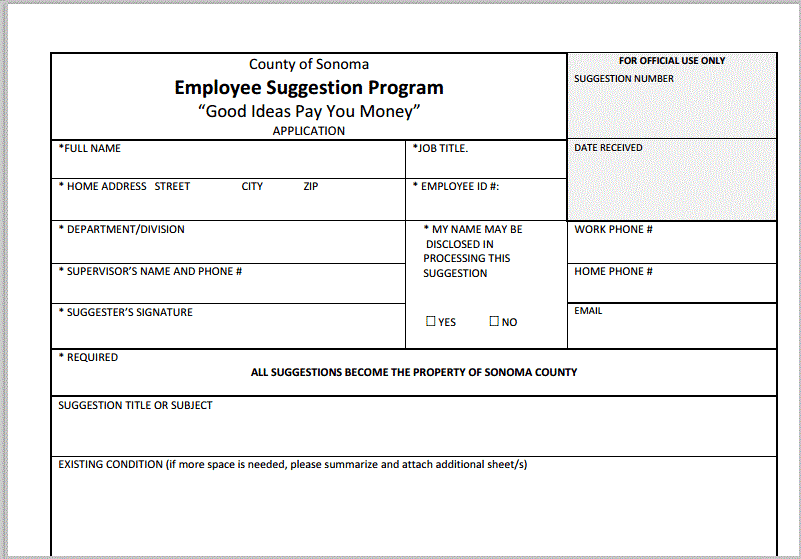
Advantages
Disadvantages
Used by (amongst others):

According to CHRIS GRIFFITHS, writing for the Globe and Mail "The most effective and low-tech way to solicit advice is to use an anonymous, locked, comment box that is accessible to all employees. A comment box allows even the most shy of staffers send a message."
However, not everyone (including us) believes the old fashion wooden suggestion box is the way to go. Jeff Dance, writing for Fresh Consulting wrote the very critical No one feels happy walking away from the suggestion box and says "The suggestion box is often a physical “black box” where ideas are locked up rather than an iterative process."
Much less plentiful than in past years, a wooden/plastic suggestion box has both advantages and disadvantages. We view it as the least effective option but it’s still more effective than having nothing in place at all!
Advantages
Disadvantages
Used by (amongst others):

We've trawled through eight different policies from cities and counties around the country and created a matrix of info (the Matrix is included in the PDF edition of this guide.). We’ve identified 18 Common sections and we recommend you add them all to your policy. We realize that time is limited though, so we've ranked them in order of importance:
If you want to go one step further and include Patents, Salem has again got a good clear set of terms. Perhaps they will let you use them: “If an employee subsequently obtains a patent for a suggestion for which he/she has received an award, all benefits from the patent shall accrue to the suggester provided that the City shall be entitled to use the patented idea, feature, device, product, process, apparatus, or design without charge".
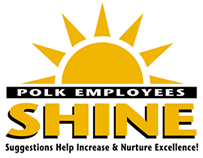
To help you get inspired, here are a selection of names from existing programs:
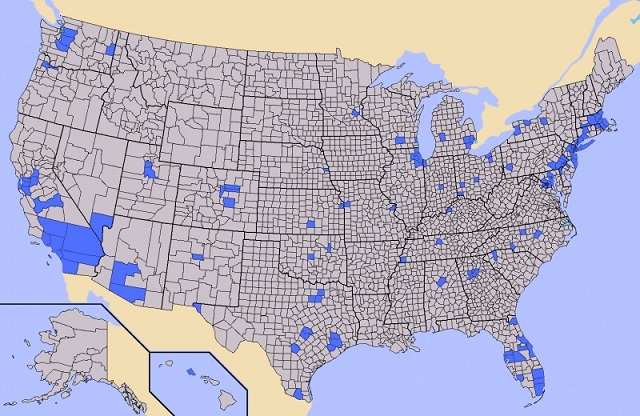
We got a lot of help making this guide from fine folks spread across the nations. I'm sure you can probably find some nearby to help too. If you've got any links to add here, please contact us and we'll add them.
Written by Duncan Murtagh April 10, 2014
Give Vetter a try?
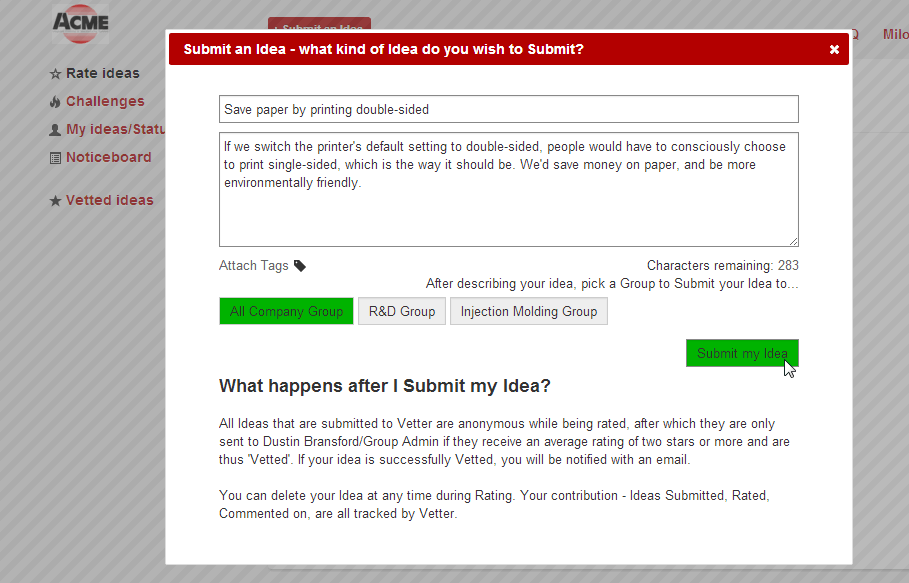
If you've gotten value out of this guide and reckon we know what we're talking about... then please give Vetter a try with a trial Suggestion Program at your City or County. You can find out more about how it works by clicking this link.
"We wanted an online suggestion box that's easy to run and Vetter fits the bill"
Heather Saunders; ECITB Product Dev. Platform Manager
Book a Demo
